| Common name | Synonyms | Image | Origin | First developed and introduced | Comment | Use and Cold storage [2] [3] | Harvest (days from full bloom) [4] [5] [6] and Fireblight susceptibility [7] [8] F1 =very resistant, F5 = very susceptible. |
|---|
| Abate Fetel [9] | Abbé Fetel |  | France | 1869 | Scab susceptible. A major cultivar in Italy [10] | Eating -1 °C 90 days | 140–165 F3 |
| Alexander Lucas [11] [12] [13] [14] [15] [16] | Lucas, Lukas, Beurré Alexander |  | Loire et Cher, France | 1870, introduced 1874 | Triploid | eating -0.5 °C 120 days. | 157 F1 |
| Alfa [17] | |  | | | | | F1 |
| Ambrosia [18] | | | Indiana, US | cross made 1978 | Pick mid August. Tolerant to fire blight. | eating. 1 °C 42 days | |
| Angelys [19] | |  | Angers, France | introduced 1999 | Parentage Doyenné d' hiver x Doyenné du Comice. Pick 10 days after Doyenne du Comice | eating, -0.5o 180 days | F4 |
| Angouleme see Duchesse d'Angouleme |
| Anjou see Beurré D'Anjou |
| Anjou Red [20] | | | | | Sport of anjou with a red surface color. Not as vigorous as Anjou. |
| Ayers | | | United States | | an interspecific P. communis× P. pyrifolia hybrid | |
| Bambinella | | | Malta | | | |
| Bartlett see Williams |
| Bartlett Max Red [20] [21] | | | Europe | 1945 | A red sport of Bartlett. Slightly more fire blight resistant than Bartlett |
| Bartlett Red Sensation [20] [22] | Sensation Red Bartlett | | Australia | 1940 | A red sport of Bartlett. Tree is slower growing. |
| Beth | | | England | introduced 1974 | AGM in 1993. Parentage Beurre Superfin x Williams Bon Chretien. |
| Beurre d' Anjou [23] [24] [25] [26] [27] [28] | D' Anjou, Beurré Gris, |  | France | <1628 | | eating -0.5 °C 150 days | 140–165 F2 |
| Beurré d'Arenberg see Glou Morceau |
| Beurré Bedford [29] | | | Bedford, England | Raised 1902, introduced 1921 | Parentage Marie Louise x Durondeau | Eating in October and November |
| Bell [30] | | | West Virginia, US | cross made 1983 | Fire blight resistant. | eating | |
| Beurré Bosc see Bosc |
| Beurré Clairrgeau see Clairgeau |
| Beurré Diel [31] [32] [23] [28] [27] | |  | Belgium | <1830 | | eating -0.5 °C 120 days | |
| Beurré Durandeau [33] [34] [35] [28] | De Tongrés, Tongeren, Tongern, Tongre, Durandeau, Durondeau | 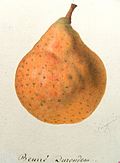 | | <1823 | Pick late September – early October. | eating, canning -0.5 °C 150 days | |
| Beurré Giffard [36] [37] [23] [20] [38] [27] [28] | Giffard |  | Angers, France | 1825 | Poor keeper | eating | 100–120 |
| Beurré d'Hardenpont see Glou Morceau |
| Beurré Hardy [ fr ] [39] [40] [23] [24] [41] [42] [26] [27] [43] [44] [45] [28] [46] | Hardy, Beurre Hardy, ge. Gellerts Butterbirne |  | Boulogne-sur-Mer, France [47] | c1820, introduced c1840 | AGM in 1993. Biennial bearing. | Eating -0.5 °C 90 days | 130–150 F2 |
| Beurré de Mérode see Doppelte Philipp |
| Beurré Superfin [48] [49] [23] [28] [20] [27] | |  | Angers, France | 1837 | AGM in 2006. Ripens in late September. | Eating | |
| Black Worcester | |  | England | | a cooking pear that keeps well | Cooking | |
| Blake's Pride [50] | |  | United States | cross made 1965, introduced 1998 | derived from a cross of US 446 x US 505, made by H.J. Brooks [50] | |
| Blanquilla | 'pera de agua' and 'blanquilla de Aranjuez' |  | Spain | | | eating | 100–130 F1 |
| Bon Chrétien see Willams |
| Bonne de Malines see Winter Nelis |
| Bon Rouge | | | | | cultivar derived from a rare, spontaneous bud mutation of the green pear cultivar William’s Bon Chretien [51] | |
| Bosc [52] [23] [53] [26] [54] [55] [56] [57] [58] [59] | Beurré Bosc, Bosc's Flaschenbirne, Kaiser Alexander |  | Belgium | <1807 | Good for eating, baking, cooking, broiling, especially poaching. | eating, baking -1 °C 120 days | 150–165 F1 |
| Bristol Cross [60] | | | Bristol, England | cross made 1920 | Parentage Williams x Conference | eating | 142 |
| Butirra Precoce Morettini [20] [61] [26] [62] | Beurré précoce Morettini [ fr ] |  | Florence, Italy | 1956 | Parentage: Coscia x Williams (Bartlett) made by Morettini. Tree is vigorous. Ripens 20 days before Bartlett. One of the best early pears. | eating | 100–125 |
| Carmen [63] [64] | |  | Italy | cross made 1980, selected 1989, introduced 2000 | Pick 18 days before Bartlett. | eating | |
| Cascade [65] | | | Oregon, US | 1975 | A red-skinned pear. Parentage Bartlett Max Red x Doyenné du Comice. | eating | |
| Catillac [66] [67] [28] [68] [27] | Cadillac, De Citrouille, De Bell, Grand-Mogul, Grand-Tamerlan, Monstrueuse des Landes, Pound Pear, Tete-de-Chat | | France | <1665 | scab resistant pear for organic gardening. | Cooking | |
| Celina [63] | QTee | | Sweden & Norway | cross made 1985, selected 1997 | Pick 17 days before Conference. Parentage Colorée de Juillet x Bartlett. | eating |
| Charneu, Charneux see Fondante de Charneux |
| Chojuro [26] | | | Japan | 1895 | | eating | 140–155 |
| Churchland | | | | | | |
| Clairgeau [69] [23] [20] [70] [27] [71] [72] [28] | Beurré Clairgeau |  | Nantes, France | c.1830, introduced 1851 | Tree is healthy and productive. Excellent dessert quality. | eating, cooking -0.5 °C 60 days |
| Clapp's Favourite [73] [74] [23] [24] [20] [75] [76] [77] [78] [79] [80] [28] | Clapps |  | Dorchester, Massachusetts, US | c. 1860, introduced 1867 | Susceptible to scab. Very susceptible to fireblight | eating -0.5 °C 60 days | 105–130 |
| Clara Frijs [81] | Comtesse Clara Frijs | 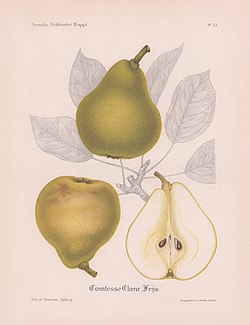 | Skensved, Denmark [82] | <1858 | major cultivar in Denmark | Eating |
| Claude Blanchet | |  | Vienne, Isère, France by M BLANCHET [83] | 1877 [83] | Random seedling [83] | |
| Colorée de Juillet [84] [27] [85] | Bunte Juli |  | Rouen, France | 1857, introduced 1867 | | eating | 90 |
| Comtesse de Paris [86] [87] | Paris |  | Eure-et-Loire, France | 1884?, 1893? | Pick late October. Use December-February | eating -0.5 °C 180 days | 165 |
| Concorde [61] [88] [89] [90] | |  | England | introduced 1984 | AGM in 1993. Susceptible to fireblight. Parentage Doyenné du Comice x Conference | |
| Condo [91] | | | Wageningen, Netherlands | 1965 | Parentage Conference x Doyenné du Comice | -1o C 120 days | |
| Conference [92] [93] [61] [94] [95] [26] [96] [97] [98] [99] [100] | Rivers' Conference |  | Sawbridgeworth, Hertfordshire, England | 1884, introduced 1894 | FCC in 1885. AGM in 1993. Susceptible to fireblight and canker. | eating -0.5 °C 120 days | 160–180 F1 |
| Corella | |  | Australia | late 19th century [101] [102] | Barossa Valley in southern Australia by German settlers [101] | |
| Coscia [103] | | | Italy | <1800 | very early maturing cultivar | eating | 90–120 F1 |
| Curé see Poire de Curé |
| D'Anjou see Beurré d' Anjou |
| Delfrap [104] | Delbard Premiere | | France | 1955 | Preharvest drop. | eating | |
| Dessertnaja | | | | | | |
| Dicolor [105] | |  | | | pick late september | eating | F4 |
| Don Guindo | | | Spain | | strong yellow, flavoured taste | |
| Doppelte Philipp [106] [107] [108] | Beurré de Mérode, Doyenné de Mérode, Albertine, Doyenné Boussoch |  | Belgium | c.1800, introduced 1819 | Pick september. Use November | |
| Doyenné d' hiver see Easter Beurre | |
| Doyenné du Comice [109] [110] [111] [24] [20] [112] [113] [26] [114] [115] [116] [117] [118] [119] [28] | Comice, Vereinsdekant, Offered as "Royal Riviera Pears" by Harry & David |  | Angers, France | <1849 | FCC in 1900. AGM in 1993. Biennial bearing. Preharvest drop. Vigorous tree, erratic cropper. | eating -0.5 °C 90 days | 150–170 F5 |
| Doyenné de Mérode see Doppelte Philip |
| Drouard see President Drouard |
| Dr. Jules Guyot [120] [28] [121] | |  | Troyes, France | c1870 Introduced 1875 | Scab resistant pear for organic gardening. Poor keeper. | eating, 0 C 25 days | 105–125 F2 |
| Duchess [122] | Dyushes, Dushes | | England? France? | late 18th c. [123] | Pick early October | eating, canning | |
| Duchesse d'Angouleme [23] [24] [20] [124] [28] | Angouleme |  | France | 1809, introduced 1815 | Large tree, bears reulary. Good fire blight resistance. | eating | 150–170 |
| Durondeau se Beurré Durondeau |
| Earlibrite | | | | | | |
| Easter Beurré [125] [28] | Doyenné d' hiver, Winterdechantsbirne | | Belgium | c1823 | Use December- March | eating | 160–185 |
| Edelcrassane see Passe Crassane |
| Eden | | | Israel | | | |
| Eldorado [20] | | | California, US | 1945 | Very good to excellent quality. Long storage life. | Eating, Canning | 140–160 F1 |
| Elektra | | | | | | | F5 |
| Epine du Mas [126] | Belle de Limoges, Beurré Rochechouart, du Mas |  | Rochechouart, France | <1847 | | eating, 0 C 100 days | |
| Flamingo [61] | | | South Africa | introduced 1993 | Parentage Bon Rouge x Forelle. Flesh: creamy white, soft. | eating | |
| Flemish Beauty [23] [24] [20] [28] | Fondante des Bois |  | Flanders, Belgium | 1810 | Hardy to -45 degrees F. | Eating, drying | 160–180 |
| Fondante d'Automne [127] [128] [28] | | | France | c. 1825 | An old Flemish variety raised by Fievee at Maubeuge [129] | |
| Fondante de Charneux [130] [131] [132] [133] [134] [28] | Charneux, Merveille de Charneu, Köstliche von Charneeux, Légipont, Merveille de Charneu, Waterloo, |  | Charneux, Belgium | c1800 | Susceptible to fireblight | eating -0.5 °C 100 days | 144 |
| Forelle | |  | | | | eating | 160–190 |
| Gellert see Beurré Hardy |
| Gem [63] | | | West Virginia, US | cross made 1970, selected 1981, introduced 2014 | Pick early September in West Virginia and Oregon. | eating | |
| General Leclerc [135] [136] | |  | Angers, France | 1950 ,introduced 1974 | Parentage Doyenne du Comice x ? | Eating -0.5 °C 150 days |
| Gerburg | | | | | | |
| Giffard se Beurré Giffard |
| Glou Morceau [137] [138] [23] [139] [27] | Beurré d'Hardenpoint Beurré d'Arenberg, Hardenponts Winterbutterbirne |  | Belgium | 1750 | Use November – December. | eating -0.5 °C 120 days | 170–200 |
| Gourmet [140] [141] | | | South Dakota, US | cross made 1954, selected 1969 | Width 56–74 mm. Flesh: firm, yellow, crisp ,juicy. Pollen-sterile [142] Pick 3rd week in September in South Dakota. | eating | |
| Golden Spice | | | | | Small fruit, very hardy [142] | |
| Gorham [20] | | | New York, US | Introduced 1923 | Parentage Bartlett x Josephine de Malines. AGM in 2006. Ripens 14 days later than Bartlett | |
| Grand Champion [143] | | | Oregon, US | 1936 | Bud mutation from Gorham | |
| Grüne Jagdbirne [144] | | | Germany ? | <1936 | Pick late October. | Perry | |
| Hardy see Beurré Hardy |
| Harobig | | | | | | |
| Harovin Sundown | | | | | | |
| Harrow Crisp | | | | | | |
| Harrow Delight [20] | | | Ontario, Canada | Introduced 1982 | Hardy in zone 5 | |
| Harrow Gold | | | | | | |
| Harrow Red | | | | | | |
| Harrow Sweet [141] [145] [146] | | | Ontario, Canada | cross made 1965 | | | F1 |
| Harvest Queen [20] [147] | | | Ontario, Canada | introduced 1982 | Parentage: Williams x(Williams x(Williams x Seckel)) | Eating, Canning | |
| Hermann | | | | | | |
| Herzogin Elsa [148] | Elsa | | Germany | 1879 or 1885 | Pick late September | eating | |
| Hessle [149] [28] [150] | Hazel | | Yorkshire, England | <1827 | disease resistant pear for organic gardening | eating | |
| Highland [151] | | | US | cross made 1944 | Parentage Willams x Doyenné du Comise | eating | |
| Honeysweet [152] | | | US | cross made 1955, selected 1969 | Width 55–61 mm, height 61–67 mm. Parentage Seckel x (Vermont Beauty x Roi Carlo de Wurtenberg). Pick early september. Flesh: buttery, sweet, rich. | eating | |
| Hortensia [63] | | | Dresden-Pillnitz, Germany | introduced 1996 | Parentage Nordhäuser Winterforelle x Clapp Favorite. Pick mid to late September. | eating | |
| Hosui (豊水) (Pyrus pyrifolia subsp. culta) [141] [153] [154] [155] | 'Russet pears', Russet apple pear |  | National Institute of Fruit Tree Science, Japan | c. 1972 | | Cider, cooking, eating | 135–145 |
| Huntington | | | | | | |
| Ingeborg [156] | | | Balsgård, Fjälkestad, Sweden | 1994 | Parentage Conference x Bonne Louise. Triploid. Main pear cultivar in Norway | eating | |
| Isolda [157] | |  | | | Susceptible to fireblight | eating | F2 |
| Jargonell [158] [159] [23] [28] [160] [161] | Bellissme-Jargonelle, Figue d'Été, Grosse-Jargonelle, Sabine d'Été, Vermillon d'Été |  | France | <1690 | Tree is hardy, healthy and vigouros | eating | |
| Jeanne d'Arc [162] | | | Rouen, France | introduced 1893 | Parentage Diels Butterbirne x Doyenne du Comice | eating |
| Joséphine de Malines [163] [164] [23] [24] [165] [28] [166] | Josephine von Mecheln | 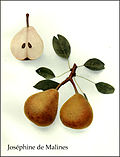 | , Mechelen(a.k.a. Malines), Belgium | 1830 | FCC in 1901. AGM in 1993. Obtained by Esperen, pomologist and mayor of Malines in the 19th century; one of the best late season pears. Pick late October. Use January – March. | eating -0.5 °C 120 days | |
| Kaiser Alexander see Bosc |
| Kalle see Starkrimson |
| Kieffer [23] [24] [20] | |  | United States | | a hybrid of the Chinese "sand pear", P. pyrifolia and probably 'Bartlett'. Hardy in Zones 4–9. | eating, canning, baking | 170–190 |
| Kikusui [20] | Kikisui | | | | Pyrus pyrifolia. Not suitable for shipping. | eating | |
| Kosui [141] [167] (幸水) | Russet apple pear | 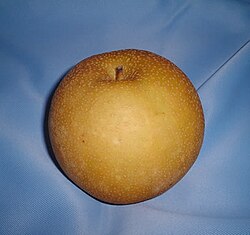 | National Institute of Fruit Tree Science, Japan | c. 1959 | the most important cultivar in Japan), [168] [169] ('Russet pears')Pyrus pyrifolia subsp. culta | Cider, cooking, eating | 120–130 |
| La France [170] | | | Vienne, Isere, France | 1864 | | |
| Lategale | | | | | | |
| Laxton's Superb [171] [172] | | | England | Raised 1901, Introduced 1913, Introduced in US 1937 | Parentage Beurré Superfin x Bartlett. No longer used due to high susceptibility to fireblight | |
| Le Conte [23] [20] | |  | | | Pyrus communis x P. pyrifolia.Vigorous tree. | |
| Liegel [23] [173] | Liegels Winterbutterbirne |  | Malines, Belgium | 1788 | | |
| Louise Bonne [174] [175] [23] [24] [176] [54] [177] [27] [178] [179] [180] [181] [28] [182] | Bonne Louise d'Avranches, Louise Bonne d'Avranches, Bonne Louise of Jersey, Gute Louise von Avranches |  | Normandy, France | 1778 | Scab susceptible | eating -0.5 °C 120 days | 141 |
| Luscious [20] | | | South Dakota, US | Introduced 1967 | Small-medium Bartlett-like fruit. Hardy in Zone 4 [142] | eating |
| Magness [20] | | | Maryland, US | Introduced 1960 | Hardy in Zone 6–9. Resistant to fire blight. | |
| Maxine [20] | | | Ohio, US | Introduced 1923 | Hardy in zones 4–8. |
| Merton Pride | | | England | 1941 | | |
| Moonglow [20] | | | | Introduced 1960 | Parentage Doyenne du Comice x ? Hardy in zones 5–8. | eating, canning |
| Moorcroft [63] [28] | Stinking Bishop | | Colwall, England | <1884 | Pick mid to late September | Perry | |
| Chinese White Pear ( Pyrus bretschneideri ) | Nashi | 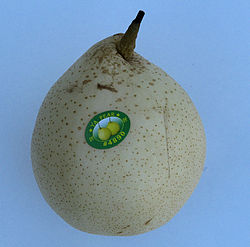 | | | | |
| Nashi | Asian / Japanese / Chinese / Korean / Taiwanese / sand pear |  | | | Pyrus pyrifolia | |
| Nijisseiki (二十世紀) name means "20th century", also spelled 'Nijusseiki' [141] [183] [184] [185] [26] | Green pears |  | Matsudo, Chiba, Japan | c. 1888 | Green apple pear. (Pyrus pyrifolia subsp. culta) | Cider, cooking, eating | 140–155 |
| Nordhäuser Winterforelle [186] | |  | Nordhausen, Germany | introduced 1864 | Pick mid-October. Use January – March | eating -0.5 °C 120 days | |
| Oberösterreichische Weinbirne [187] | | | Austria | old | Pick mid-October | Perry | |
| Oldfield [63] [28] | | | Herefordshire, England | early 1700s | Pick mid to late October. Mill 3–6 weeks after harvest. | Perry | |
| Onward [188] | | | National Fruit Trials in Wisley, Surrey | 1947 | Laxton's Superb x Doyenne du Comice [189] | Eating |
| Orcas [141] [190] | | | Washington, US | 1966 | Cold storage 11 weeks | | 112–132 |
| Orient [20] | | | United States | | an interspecific P. communis × P. pyrifolia hybrid. Hardy in zones 5–8. | canning |
| Packham [191] [26] [192] | 'Packham's Triumph' |  | Australia | 1896 | Parentage Uvedale's St. Germain x Williams. | eating -0.5 °C 90 days | 150–165 F4 |
| Paragon [63] | | | Oregon, US | cross made in 1940s | Flesh fine-textured with exquisite flavor. Tree vigorous. | eating | |
| Parker [20] | | | Minnesota, US | | Large Bartlett-like fruit [142] | |
| Paris see Comtesse de Paris |
| Parsonage | | | New Rochelle, New York | c. 1857 | | |
| Passe Crassane [193] [194] [26] [195] [28] | |  | Rouen, France | 1855 | A variety developed by M. Boisbunel, a nurseryman from Rouen, France [196] | Eating -0.5 °C 150 days | 180–210 F4 |
| Patten [20] | | | Minnesota, US | | Hardy to -50 degrees F. Large tender and juicy fruit. | Eating, canning |
| Petersbirne [197] | Grosse Petersbirne |  | Germany | <1799 | | Cooking, juice, drying. -0.5 °C 30 days | |
| Piérre Corneille [198] | | | France | <1895 | Biennial bearing. | eating | |
| Pineapple [20] [199] [200] | | | United States | | an interspecific P. communis × P. pyrifolia hybrid. Hardy in zone 8–9 | eating, canning |
| Pitmaston [201] [202] [23] [24] [203] [28] | Pitmaston Duchess, Williams' Duchess | | Worcester, England | 1841 | FCC in 1874 | eating, canning |
| Poire de Curé [204] [205] [206] [207] [28] | Curé, Bon Curé, Vicar of Winkfield, Pastorenbirne |  | Indre, France | 1760 | Triploid. Pick October. Use December-January | eating, cooking, 0 C 130 days |
| Potomac [141] | | | US | cross made 1961 | Parentage Moonglow x Beurrè d' Anjou. Width 65 mm. Pick 2 week after Bartlett. Flesh: buttery, reminding Beurré d'Anjou | eating |
| President Drouard [23] [208] | Präsident Drouard |  | Angers, France | Introduced 1870 | Pick mid-October. Use November-January | eating |
| Prècoce de Trévoux [209] [210] [211] | |  | France | 1862 | Scab susceptible. | eating -0.5 °C 50 days | 105 |
| Precoce Moretini see Butirra Precoce Morettini | Early Moretini variety |  |
| Red Clapp's see Starkrimson |
| Rescue [141] | | | Vancouver, B.C. | <1976 | Width 75–85 mm. Pick 6 days before Bartlett. Flesh: cream-colored, melting, juicy, reminding Clapp's Favorite. | eating, 1 °C, 12 weeks | |
| Rocha | Pêra Rocha |  | Portugal | | | eating, 0 C 210 days |
| Robert de Neufville [212] | | | Geisenheim, Germany | cross made 1896 | Parentage: Auguste Jurie x Clapp's Favourite. Pick late August. Flavour comparable with Doyenné du Comice | eating | |
| Rosemarie [141] | | | South Africa | cross made 1974 | Parentage Bon Rouge x Forelle [213] | |
| Santa Maria [214] | |  | Italy | introduced 1951 | Parentage Williams x Coscia | eating | |
| Schweizer Wasserbirne [215] | | | Switzerland ? | old | Triploid. Juice yield 75–80% | juice, drying | |
| Seckel [23] [24] [216] [20] [54] [28] | Seckle |  | United States, Philadelphia area | late 17th century | Some fireblight resistance. Hardy in zone 5–8. | eating | 120–140 |
| Shenandoah [217] | | | Kearneysville, West Virginia, US | selected 1985, introduced 2003 | Harvest maturity similar to Beurre d' Anjou | eating | |
| Shinseki [141] [20] [26] | |  | | | Hardy in zone 6–9. | eating | 125–135 |
| Starkrimson [20] [218] | Kalle, Red Clapp's | | Michigan | Discovered 1939, Introduced 1956 | a red-skinned bud mutation of Clapp's Favourite. Its thick, smooth skin is a uniform, bright and intense red, and its creamy flesh is sweet and aromatic. [219] | |
| Stinking Bishop see Moorcroft | | | | | | |
| Siberian | | | | | Extremely hardy with inedible fruit, used as a pollinator [142] | |
| Summer Beauty | | | | | | |
| Summercrisp [141] | | | Minnesota, US | Introduced 1987 | Cold storage 6 weeks. Crisp texture is similar to Asian Pears, medium sized mildly sweet fruit [142] | |
| Sweet Sensation [220] | Rode Doyenné van Doorn |  | Netherlands | discovered 1992, introduced 2010 | mutation of Doyenne du Comice | eating | |
| Taylor's gold | | | New Zealand | | a russeted mutant clone of 'Comice' | |
| Tongeren, Tongern, Tongre see Beurré Durandeau |
| Tosca | | | | | | |
| Trévoux see Prècoce de Trévoux |
| Triomphe de Vienne [221] [222] [223] [224] | Triumph |  | Isère, France | introduced 1874 | Biennial bearing. | eating | 156 |
| Tsu Li [225] [20] | Tse Li | | | | Pyrus pyrifolia | eating | 150–165 |
| Turandot [63] | | | Italy | cross made 1980, introduced 2000 | Parentage Dr. Guyot x Bella di Giugno. Susceptible to fire blight. | eating | |
| Tyson [23] [24] [20] [28] | Early Sugar Pear |  | Philadelphia, US | 1794 | Tree is hardy and fireblight reistant. Hardy in zone 5–8. Pick early August. | eating |
| Ure | | | Morden, Manitoba | | Juicy, small-medium fruit [142] | |
| Uta [63] [226] | |  | Dresden-Pillnitz, Germany | 1993 | Parentage Madame Verte x Beurré Bosc. Pick mid-October | eating, ? °C 135 days | |
| Verdi [227] | | | Wageningen, Netherlands | 1966 | | |
| Vicar of Winkfield see Poire de Curé |
| Virgouleuse | | | | | | |
| Williams [228] [229] [23] [230] [231] [26] [54] [232] [233] [234] [235] [28] | Williams Christ, Williams' Bon Chrétien
Bartlett (United States)
Red Bartlett (United States) |  | Berkshire, England | 1770 | Susceptible to scab and fireblight. Many are yellow. There are three major red-skinned mutant clones: 'Max Red Bartlett', 'Sensation Red Bartlett', 'Rosired Bartlett' Good for eating, baking, cooking. In a recipe specifying apples, substituting one of these pears can give joy. | eating, canning -1 °C 60 days | 115–135 F3 |
| Winter Nelis [236] [237] [23] [24] [20] [26] [54] [28] [27] | Bonne de Malines, Beurré de Malines, Coloma d' Hiver, Nélis d'Hiver, |  | Malines, Belgium | <1818 | FCC in 1902. Resistant to fireblight. | Eating -1 °C 120 days | 160–185 |
| Xenia [220] | Noiabriskaia, Nojabrskaja | | Netherlands | cross made 1968, selected 2001, introduced 2008 | Parentage Triomphe de Vienne x Nicolai Krier. Pick 2 weeks after Conerence. | eating, 1 °C 90 days. | |
| Ya Li [141] [20] | | | | | Pyrus pyrifolia | eating | 150–165 |
| Yakumo [20] | | | | | Pyrus pyrifolia | eating | |







































































